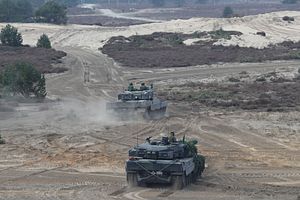Last week, Singapore and Germany concluded bilateral live-firing drills as part of another iteration of a wider annual exercise between the two countries’ militaries. The development put the spotlight on a significant engagement within the broader and growing defense ties between the two countries.
As I have noted before in these pages, while Singapore-Germany defense ties are not new, there have been efforts by both sides to further develop relations, which in the defense realm include high-level visits and exchanges, policy dialogues, technological collaboration, and military exercises. Over the past few years, both sides have explored new areas of collaboration, such as the cyber domain and handling fake news, as well as working towards renewing formal arrangements including an enhanced Defense Cooperation Agreement (DCA).
That has continued into 2019 as well. Indeed, just last month, the defense relationship was in the headlines again as Singapore officially announced the launch of the first of a net of new submarines for the Southeast Asian state at TKMS shipyard in Kiel, Germany in a ceremony attended by Singapore’s Defense Minister Ng Eng Hen, who had also attended the annual Munich Security Conference earlier. As I noted then, while the headlines were dominated with a focus on the submarines themselves, they were in fact also a reflection of ties between the two sides with German assistance and education as they continue to be developed (See: “What’s in Singapore’s First New Attack Submarine Launch?“).
One of the features of the Singapore-Germany defense relationship is Exercise Panzer Strike, which the two sides have held since 2009. Over time, the exercise has grown in both scale and complexity, and, importantly, the Singapore Armed Forces (SAF) are now able to train at the Oberlausitz Military Training Area (OMTA) in Germany – itself about a quarter the size of Singapore which given the SAF the flexibility to train without the space constraints they experience at home, including concurrent live-firing of up to four ranges for armored units and engaging targets at greater range.
Last week, the defense aspect of the relationship was in the spotlight again with the conduct of another exercise. The Singapore Armed Forces (SAF) and the Bundeswehr (German Armed Forces) conducted a bilateral live-firing exercise as part of the eleventh iteration of Exercise Panzer Strike from March 18 to March 20.
Per Singapore’s defense ministry (MINDEF), the bilateral live-firing exercise at the Oberlausitz Military Training Area (OMTA) involved 170 servicemen from 1st Company, 48th Battalion Singapore Armored Regiment (48 SAR) with their German Army counterparts from Panzerbataillon 393. The wider Exercise Panzer Strike involved approximately 1200 servicemen from 48 SAR and Armor Training Institute (ATI), as well as 14 Leopard 2SG Main Battle Tanks (MBT) and 16 Bionix Infantry Fighting Vehicles (IFV).
































